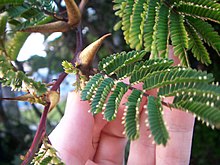
A Beltian body is a detachable tip found on the pinnules of some species of Acacia and closely related genera. Beltian bodies, named after Thomas Belt, are rich in lipids, sugars and proteins and often red in colour. They are believed to have evolved in a symbiotic relationship with ants. The ants live inside special plant structures (domatia) or near the plant and keep away herbivores.
Other ant-mutualism related plant structures include Beccarian, Mullerian and pearl bodies.
Unique among spiders for its predominantly herbivorous diet, Bagheera kiplingi feeds almost exclusively on Beltian bodies.
See also
References
- Eubanks, Micky D.; Kimberly A. Nesci; Mette K. Petersen; Zhiwei Liu; Horacio Bonfil Sanchez (1997). "The exploitation of an ant-defended host plant by a shelter-building herbivore" (PDF). Oecologia. 109 (3): 454–460. Bibcode:1997Oecol.109..454E. doi:10.1007/s004420050105. PMID 28307543. S2CID 841415.
- Herrera, Carlos M.; Olle Pellmyr (2002). Plant-animal Interactions: An Evolutionary Approach. Blackwell Publishing. ISBN 0-632-05267-8.
- Meehan, Christopher J.; Eric J. Olson; Matthew W. Reudink; T. Kurt; Robert L. Curry (2009). "Herbivory in a spider through exploitation of an ant–plant mutualism". Current Biology. 19 (19): 1591–1682. doi:10.1016/j.cub.2009.08.049. PMID 19825348. S2CID 27885893. [REDACTED]
External links
- Armstrong, W.P. "Central American Swollen-Thorn Acacias". Archived from the original on 11 January 2010.
This plant morphology article is a stub. You can help Misplaced Pages by expanding it. |